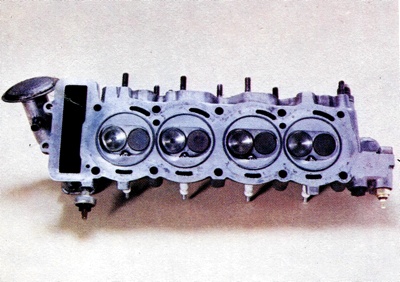
Cylinder Head showing the curved water channels clearly. These line up with identical passages in the engine block.
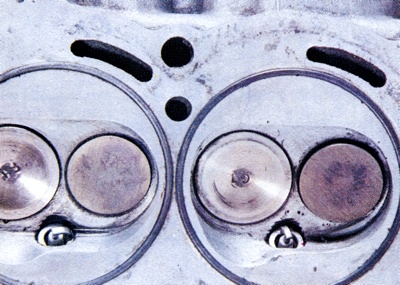
A close up of the image above. The water channels must be close to the combustion chamber to provide adequate cooling, but far enough away that they do not weaken the head.
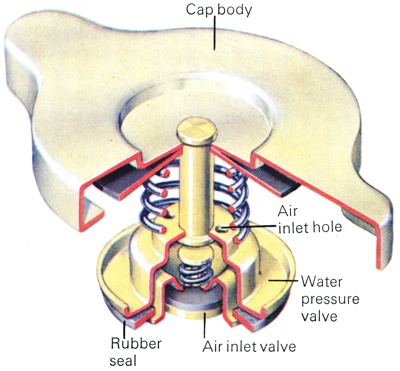
Radiator pressure cap, as found on most older cars. The large spring controls the blow-off pressure, the other regulates the air-intake.
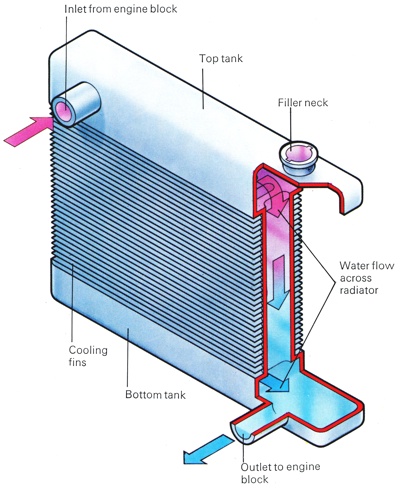
A radiator as found on most older cars.
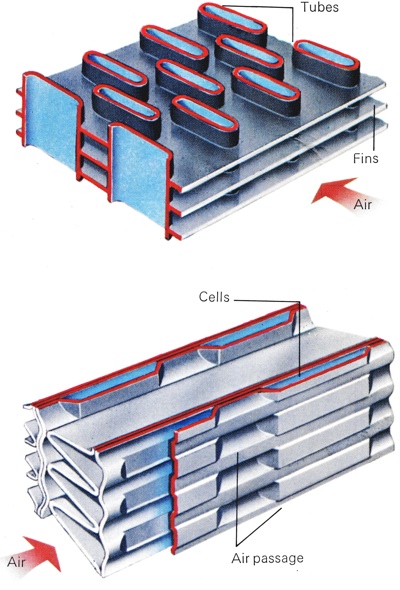
Radiator core close-up, at top the tubular type, below the cellular type.
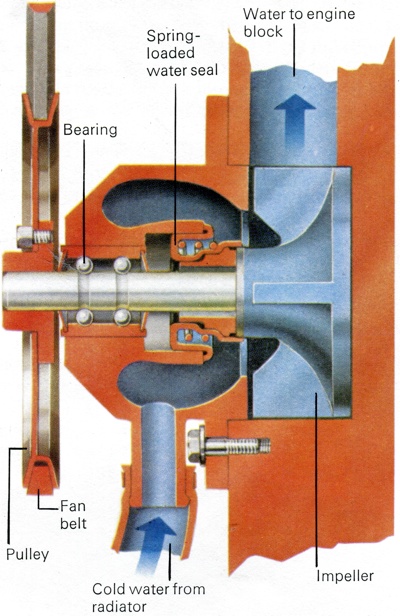
Fan-belt driven water pump, which draws cool water through the hose and forces it into the passages in the engine block.
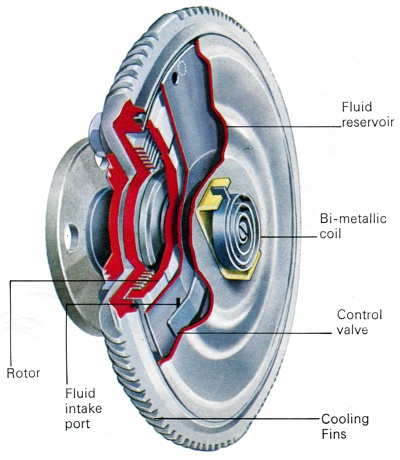
A viscous coupled fan, with a fluid clutch. As the temperature of air coming through the radiator rises, the bi-metallic coil expands and opens the control valve. This forces more fluid into the rotot chamber, the cluth bites harder and the fan speed rises. |
Water Cooling Systems
Most owners of water-cooled cars take the cooling system for granted. Peering into the top of the
radiator to check the water level is about the limit of their interest. The
cooling system, though, is a complex assembly of many parts, each making a vital contribution to efficient engine performance.
The central part of the
cooling system is the water jacket. This is the series of passages through which the water flows in order to absorb the heat from the engine block. The water jackets of modern engines are cast as an integral part of the engine block and
cylinder head, and the water passages run down the full depth of the block. This provides cooling for the cylinders from top to bottom. The engine block is also usually fitted with a drain cock or plug at the lowest point of the water jacket, to provide a means of draining and flushing the system.
The process of casting the engine block requires small holes to be left in the mould, so that the casting sand can be removed. These holes appear in the side of the finished engine block and are called cores. Engine manufacturers make good use of these cores as an engine safety device. After casting, the cores are machined smooth and fitted with a concave plug.
Water expands when it freezes, so if the temperature of the cooling water falls too low in severe weather the core plugs will be pushed out of the engine block, so preventing more serious damage to the engine. The channels in the water jacket line up with those in the
cylinder head, so water can flow between the two. An outlet in the
cylinder head feeds hot water back into the
radiator , while another opening in the engine block admits cooled water from the
radiator .
Radiator
Water enters the
radiator having taken the heat away from the engine. The water becomes extremely hot in the process, so the
radiator has to take the heat out of the water. It does this by channeling it through a series of fine tubes. Air flows past these tubes as the car moves along, thus cooling the water inside. The
radiator has three main components: two tanks and the central 'core'. All three are made mainly of brass to improve heat dissipation.
The tanks are mounted above and beneath the core, or on either side of the core in the case of cross-flow radiators. The upper, or 'header', tank is the larger of the two, and so allows room for the hot water to expand as it is pumped in from the engine. The
radiator filler cap is fitted to the upper tank, and the bottom of the tank is pierced at the points where the tubes of the
radiator core enter. The lower tank is similarly pierced, and the
radiator drain tap is generally fitted to this tank.
There are two types of
radiator cores in common use. The 'tubular' design consists of a number of round or oval tubes soldered into the tanks. The hot water runs down into these tubes from the header tank and air circulates between them. The tubes are made of thin brass sheet, often as fine as 0.125 mm (0.005in.) to encourage heat dissipation. This is also helped by wide copper fins that run at right angles to the tubes. Much of the heat from the water is conducted through the pipes into the fins. These spread the heat over a large area and expose it to a greater flow of air. The copper fins also protect the delicate pipes from minor knocks that might cause a leak.
The second, 'cellular', type of
radiator core is constructed of pressed metal sections, soldered together to form a series of narrow passages. These also open into the
radiator tanks. The main difference between this and the tubular type is that the spaces between the water passages are used to carry air. Cross-flow radiators operate on the same principle as the conventional
radiator , but are simply tipped on one side, so that the water flow is across the
radiator rather than down it. This design has come into greater use as car profiles have become lower. A low bonnet obviously demands a low
radiator , which in turn means that the pipes in the core are short. The water inside is therefore exposed to the air-flow for a brief period. If the pipes run across the
radiator rather than down it, the pipes will be longer and the cooling made more efficient.
The
radiator pressure cap is an important part of the
cooling system, as it raises the boiling point of the water and therefore allows the cooling system to absorb far more heat. At sea level, at atmospheric pressure, water boils at 100�C (212�F), but if it is confined under pressure the boiling point can be increased by 1.6�C (3�F) for every psi of pressure over atmospheric. This is the effect the
radiator pressure cap has on the water. For example, if a 12psi pressure cap is fitted, the coolant will not boil until it has reached a temperature of 120�C (248�F). The danger of boiling during a long climb on a hot day is thus reduced, and the temperature at which the coolant will boil while driving at high altitudes is increased.
The filler cap has two important valves. The first holds the water under pressure. As the water in the
radiator header tank becomes hot, it expands and presses against this valve. The valve keeps the water in the header tank until the pressure of its expansion overcomes the spring controlling the valve. Once the water pressure has reached the point where it can raise the spring and open the valve, water surges out of the
radiator and through the overflow pipe. On cars with a sealed
cooling system this pipe leads to the expansion tank, but on more conventional cars it simply directs the excess water on to the road. The pressure in the
radiator then falls and the spring pushes the valve shut.
This spring therefore controls the extent to which the
radiator is pressurized. If the spring is weak the water will boil at close to the usual temperature. If the spring is strong the boiling point will be much higher. These springs are carefully manufactured, and the pressure they produce in the
radiator is usually marked on the filler cap. There is one complication to this otherwise simple system. When the water cools it contracts and creates a vacuum in the
radiator . This vacuum could cause the
radiator core to collapse under the pressure of the external air, and this is where the second valve in the cap comes in. Air enters the
radiator through the valve in the filler cap, which is opened by the vacuum in the core. The air displaces the vacuum and raises the pressure in the
radiator .
Engine baffles are fitted in the engine compartment of many cars. These baffles are simple deflectors designed to direct the air flow through the
radiator and round the engine. On some engines, a shroud on the back of the
radiator , usually surrounding the fan, causes the fan to draw the air through the total area of the
radiator core. Some cars have baffles between the grille and
radiator to ensure that the car's movement forces air past the
radiator . Water pump
The cooled water leaves the lower
radiator tank and runs through a hose to the water pump, which assists the flow of water through the
cooling system. The water will flow naturally on the thermosyphon principle, but this flow is not sufficient to cope with the heat generated by modern car engines. The pump is generally mounted on the front of the cylinder block. On some rear-engined water-cooled cars, however, the
radiator , water pump and fan are separately mounted to the side of the engine. The Chrysler Imp is an example of this system.
Regardless of their location, most water pumps work in a similar way. The pump generally consists of a cast-iron or aluminium housing with ball-bearing races in which a shaft revolves. These bearings are sealed at each end. A carbon ring is fitted to the front of the bearing housing to prevent water seeping along the shaft. Another seal at the opposite end holds in the lubricating grease and keeps out the dirt and grit that accumulates on the engine. A metal or plastic impeller is fitted to the front of the shaft. It is a small disc fitted with a number of vanes which may be either curved or straight. The impeller revolves at high speed, and water is trapped between the vanes and forced through the channel in the engine block. A pulley is fitted to the other end of the shaft and is driven, through the fan belt, by the crankshaft.
The driving speed of the water pump can cause problems in high performance engines. If the pump is driven, for example, at half the speed of the crankshaft the water circulation will probably be inadequate when the car is pulling hard in top gear. On the other hand if the ratio is stepped up to equal engine speed very serious problems can develop at peak revolutions. The suction at the inlet to the pump can become so great as to cause cavitations. This means that a pocket of steam is created in the suction area, which interrupts the flow of water through the pump. A large and expensive engine seizure is the usual consequence of cavitations, so the driving speed of the water pump has to be calculated very carefully.
Cooling Fan
The
cooling fan is usually mounted on the water pump pulley and is also driven by the crankshaft. The movement of the car at speeds above 55km/h (35 mph) is usually sufficient to produce a stream of air through the
radiator capable of keeping the water at an adequately low temperature. Another method of creating an airstream is necessary when the car's speed falls below this figure, and especially when it is standing in traffic. The fan provides this. The blades of the fan draw a steady stream of air through the
radiator .
A slightly different system is found on most transverse-engined cars, where the
radiator is mounted at the side of the engine compartment. Though the fan is mounted in the same relative position on the engine, the blades are pitched in such a way that they first draw the air through the grille, then push it through the
radiator . One of the biggest problems with a conventional belt-driven fan is that it absorbs a significant amount of the engine's power. If the blades were removed from most fans the engine would probably produce another two bhp. When the engine is overheating in traffic this has to be accepted, but the fan continues to absorb power when the car is moving at speed, at a time when the air flow through the
radiator would be quite sufficient.
Orthodox fans are also comparatively inefficient when their cooling effect is most in demand. They produce their greatest air flow when revolving at about l,400rpm. But the airflow is needed most when the engine is turning over at only about 750rpm, so a drive ratio of approximately 2:1 would be required for really efficient low-speed cooling. The problem is that most engines rev up to about 6,500rpm, so if this ratio were adopted the fan would be revolving at 13,000rpm. This would place enormous strain on the fan itself and cause it to absorb still more power in producing a large, but unnecessary, flow of air.
In view of these problems some manufacturers have developed fans that operate only when required. Many American Ford cars, for example, are fitted with a plastic 'flex fan'. The blades of these fans twist as the engine speed rises. At low speed, when the cooling effect of the fan is most required, the blades are positioned so that they draw the greatest volume of air through the
radiator . At high speeds the centrifugal force of the spinning fan twists the pitch of the blades so that they 'bite' into the air less and therefore consume less engine power.
Variable speed fans are also in use on many cars, mostly those of American origin. These have a fluid clutch mounted on the water pump pulley and controlled by a thermostat. They save power by turning over slowly when the engine is cool, but speed up considerably when the temperature reaches a pre-determined level.
Electric cooling fans are fitted as standard to some cars, and can make a worthwhile project for the DIY mechanic. The fan is driven by an electric motor, which is switched on and off by a thermostatic switch mounted either in the
radiator header tank or close to the water pump outlet. When the water temperature reaches a certain point the switch is activated and the fan turned on. When the temperature of the water falls again the thermostat closes and the fan is shut off. This system is almost ideal. The fan absorbs none of the engine power and is only in operation when it is needed. Its only drawback is that it is more expensive to manufacture and install.
Thermostats
The thermostat is located either in the upper part of the water pump housing or close to the manifold leading to the water outlet connection. The function of the thermostat is to shut off water from the
radiator when the engine is cold. This allows the engine to reach its best working temperature as quickly as possible. As the water warms up, the thermostat opens and permits circulation throughout the whole
cooling system.
Two types of thermostat are in use - the bellows and wax varieties. The less common bellows type consists of a circular concertina of thin metal containing a volatile liquid such as alcohol or ether. A stem is attached to the concertina, and mounted on the stem is a valve. When the temperature of the water is low the concertina contracts, lowers the stem and brings the valve down onto its seat. This seals off the
radiator from the rest of the cooling passages. The coolant in the water jacket then warms up, raises the temperature of the liquid in the bellows, and pushes up the stem again. This lifts the valve and allows water to flow into the
radiator .
The second and more common type of thermostat is the wax element design. The wax is sealed into a copper or brass container and is connected to a valve through a pushrod. The cold wax contracts, this closes up the valve and a spring holds it shut. As the water warms up the wax expands and pushes up the valve. In contrast with water-cooled engines, air-cooled engines have few components and are less prone to mechanical defects. Air cooling is described in the next article in this series.



